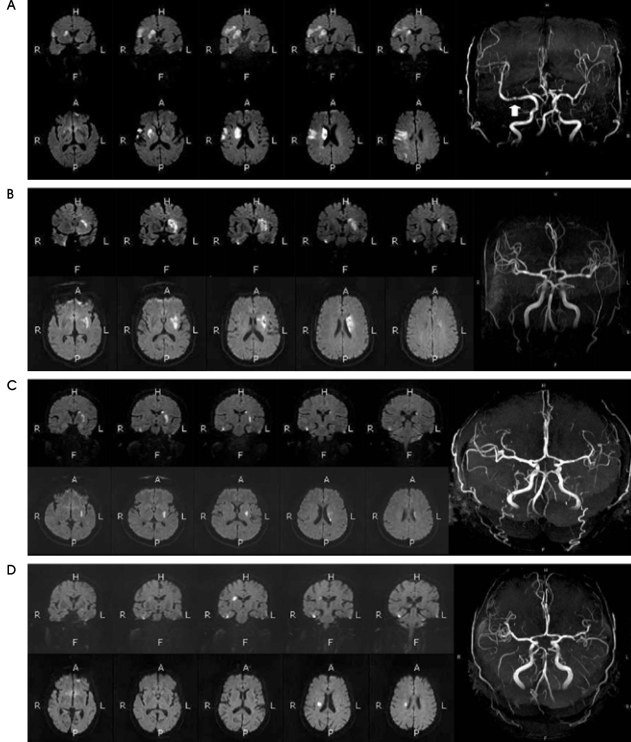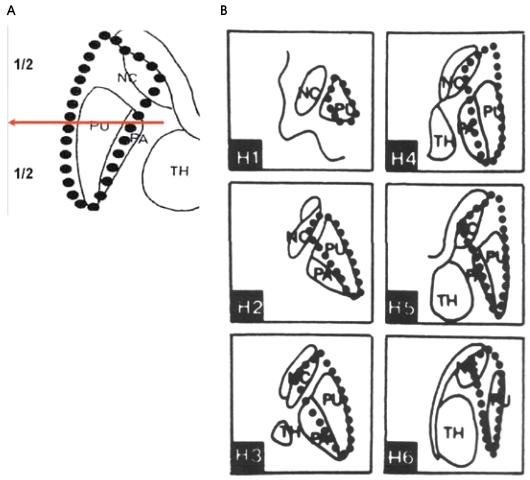J Clin Neurol.
2006 Sep;2(3):171-178. 10.3988/jcn.2006.2.3.171.
Analysis of the Lesion Distributions and Mechanism of Acute Middle Cerebral Artery Infarctions Involving the Striatocapsular Region
- Affiliations
-
- 1Department of Neurology, Soonchunhyang University College of Medicine, Seoul, Korea. neuron@hosp.sch.ac.kr
- KMID: 2287690
- DOI: http://doi.org/10.3988/jcn.2006.2.3.171
Abstract
- BACKGROUND AND PURPOSE
There is no clear description about the patterns of each mechanism of striatocapsular infarctions. The aims of our study were to elucidate differences in the distributions of lesions of acute middle cerebral artery (MCA) infarctions involving the striatocapsular region and to compare those following embolic striatocapsular infarctions with those originating from MCA disease.
METHODS
We prospectively enrolled patients with acute infarcts located in the lenticulostriate artery territory that were not lacunar infarcts. Brain coronal diffusion-weighted imaging (DWI) was obtained and magnetic resonance angiography (MRA) was carried out to evaluate the distribution of infarct lesions and MCA stenosis in all patients. The types of infarct distribution were divided into three categories: (1) dominant in the distal territory (DD), (2) distributed equally between the distal and proximal territories (DE), and (3) dominant in the proximal territory. We performed tests for embolic sources (transthoracic echocardiography, transesophageal echocardiography, Holter monitoring, and contrast-enhanced MRA including the aortic arch) in most patients. Stroke mechanisms were classified into stroke from proximal embolism, MCA disease, and stroke of undetermined etiology.
RESULTS
A total of 47 patients (28 men and 19 women; mean age, 62 years) were recruited. A proximal embolic source was significantly more prevalent in patients with a DE lesion than in those with a DD lesion. The most common proximal embolic source was of cardiac origin. In contrast, symptomatic MCA stenoses were more common in patients with a DD lesion than in those with a DE lesion.
CONCLUSIONS
These results suggest that the dominant area of striatocapsular infarction on coronal DWI is an important clue for stroke etiology. Coronal DWI could therefore be helpful to determining the mechanisms in patients with striatocapsular infarctions that are currently described as having an "undetermined etiology" according to the Trial of Org 10172 in Acute Stroke Treatment classification.
MeSH Terms
Figure
Reference
-
1. Ringelstein EB, Zeumer H, Angelou D. The pathogenesis of strokes from internal carotid artery occlusion. Diagnostic therapeutic implication. Stroke. 1983; 14:867–875. PMID: 6362094.2. Adams HP, Damasio HC, Putman SF, Damasio AR. Middle cerebral artery occlusion as a cause of isolated subcortical infarction. Stroke. 14; 948–952.
Article3. Santamaria J, Graus F, Rubig F, Arbizu T, Perez J. Cerebral infarction of the basal ganglia due to embolism from the heart. Stroke. 1983; 14:911–914. PMID: 6658994.
Article4. Bladin PE, Berkovic SF. Striatocapsular infarction: large infarcts in the lenticulostriate arterial territory. Neurology. 1984; 34:1423–1430. PMID: 6493490.
Article5. Levin RL, Lareze HI, Dobkin JA, Truski PA. Large subcortical hemispheric infarctions: presentation and prognosis. Arch Neurol. 1988; 45:1074–1077. PMID: 3052374.6. Donnan GA, Bladin PF, Berkovic SF, Longley WA, Saling MM. The stroke syndrome of striatocapsular infarction. Brain. 1991; 114:51–70. PMID: 1998890.7. Boiten J, Lodder J. Large striatocapsular infarcts. Clinical presentation and pathogenesis in comparison with lacunar and cortical infarcts. Acta Neurol Scand. 1992; 86:298–303. PMID: 1414250.
Article8. Weiller C, Ringelstein EB. Donnan GA, Norrving B, Bamford J, Bogousslavsky J, editors. Striatocapsular infarcts. Lacunar and Other Subcortical Infarctions. 2nd edn. Oxford University Press.9. Caplan LR, Gorelick PB, Hier DB. Race, sex and occlusive cerebrovascular disease: a review. Stroke. 1986; 17:648–655. PMID: 3526645.
Article10. Huang YN, Gao S, Li SW, Huang Y, Li JF, Wong KS, et al. Vascular lesions in Chinese patients with transient ischemic attacks. Neurology. 1997; 48:524–525. PMID: 9040750.
Article11. Bamford J, Sandercock P, Dennis M, Burn J, Warlow C. Classification and natural history of clinically identifiable subtypes of cerebral infarction. Lancet. 1991; 337:1521–1526. PMID: 1675378.
Article12. Sacco SE, Whisnant JP, Broderick JP, Philips SJ, O'Fallon WM. Epidemiological characteristics of lacunar infarcts in a population. Stroke. 1991; 22:1236–1241. PMID: 1926233.
Article13. Kwon SU, Cho YJ, Koo JS, Bae HJ, Lee YS, Hong KS, et al. Cilostazol prevents the progression of the symptomatic intracranial arterial stenosis. Stroke. 2005; 36:782–786. PMID: 15746463.
Article14. Gordon DL, Bendixen BH, Adams HP Jr, Clarke W, Kappelle LJ, Woolson RF. Interphysician agreement in the diagnosis of subtypes of acute ischemic stroke: implications for clinical trials. The TOAST Investigators. Neurology. 1993; 43:1021–1027. PMID: 8492920.15. Adams HP Jr, Bendixen BH, Kappelle LJ, Biller J, Love BB, Gordon DL, et al. Classification of subtype of acute ischemic stroke. Definitions for use in a multicenter clinical trial. TOAST. Trial of Org 10172 in Acute Stroke Treatment. Stroke. 1993; 24:35–41. PMID: 7678184.
Article16. Bogousslavsky J, Barnett HJ, Fox AJ, Hachinski VC, Taylor W. Atherosclerotic disease of the middle cerebral artery. Stroke. 1986; 17:1112–1120. PMID: 3544347.
Article17. Fisher CM. Lacunar infarcts: a review. Cerebrovasc Dis. 1991; 1:311–320.18. Thajeb P. Large vessel disease in Chinese patients with capsular infarcts and prior ipsilateral transient ischaemia. Neuroradiology. 1993; 35:190–195. PMID: 8459917.
Article19. Kappelle LJ, Koudstaal PJ, van Gijin J, Ramos LM, Keunen JE. Carotid angiopathy in patients with lacunar infarction. A prospective study. Stroke. 1988; 19:1093–1096. PMID: 3413805.20. Horowitz DR, Tuhrim S, Weinberger JM, Rudolph SH. Mechanisms in lacunar infarction. Stroke. 1992; 23:325–327. PMID: 1542890.
Article21. Bang OY, Heo JH, Kim JY, Park JH, Huh Kyoon. Middle cerebral artery stenosis is a major clinical determinant in striatocapsular small, deep infarction. Arch Neurol. 2002; 59:259–263. PMID: 11843697.
Article22. Lee LJ, Kidwell CS, Alger J, Starkman S, Saver JL. Impact on stroke subtype diagnosis of early diffusion-weighted magnetic resonance imaging and magnetic resonance angiography. Stroke. 2000; 31:1081–1089. PMID: 10797169.
Article23. Yucel EK, Anderson CM, Edelman RR, Grist TM, Baum RA, Manning WJ, Culebras A, Pearce W. AHA scientific statement. Magnetic resonance angiography: update on applications for extracranial arteries. Circulation. 1999; 100:2284–2301. PMID: 10578005.24. Tatu L, Moulin T, Bogousslavsky J, Duvernoy H. Arterial territories of the human brain: cerebral hemispheres. Neurology. 1998; 50:1699–1708. PMID: 9633714.
Article25. Rossberg C, Boccalini T, Wagner HJ. Ueber infarkte im Versorgungsgebiet der Aa. Lenticulostriatae. Eine neuropathologische und postmortal-neuroradiologische Analyse. Klin Neuroradiol. 1992; 2:75–84.26. Samuels OB, Joseph GJ, Lynn MJ, Smith HA, Chimowitz MI. A standardized method for measuring intracranial arterial stenosis. Am J Neuroradiol. 2000; 21:643–646. PMID: 10782772.27. Ay H, Furie KL, Singhal A, Smith WS, Sorensen AG, Koroshetz WJ. An evidence-based causative classification system for acute ischemic stroke. Ann Neurol. 2005; 58:688–697. PMID: 16240340.
Article28. Baird AE, Lovblad KO, Schlaug G, Edelman RR, Warach S. Multiple acute stroke syndrome: marker of embolic disease? Neurology. 2000; 54:674–678. PMID: 10680802.
Article29. Kang DW, Chalela JA, Ezzeddine MA, Warach S. Association of ischemic lesion patterns on early diffusion-weighted imaging with TOAST stroke subtype. Arch Neurol. 2003; 60:1730–1734. PMID: 14676047.30. Lee PH, Oh SH, Bang OY, Joo IS, Huh K. Isolated middle cerebral artery disease: clinical and neuroradiological features depending on the pathogenesis. J Neurol Neurosurg Psychiatry. 2004; 75:727–732. PMID: 15090568.
Article31. Angeloni U, Bozzao L, Fantozzi L, Bastianello S, Kushner M, Fieschi C. Internal borderzone infarction following acute middle cerebral artery occlusion. Neurology. 1990; 40:1196–1198. PMID: 2381526.
Article32. Bogousslavsky J, Regli F. Centrum ovale infarcts: subcortical infarction in the superficial territory of the middle cerebral artery. Neurology. 1992; 42:1992–1998. PMID: 1340771.33. Van der Zwan A, Hillen B, Tulleken CA, Dujovny M, Dragovic L. Variability of the territories of the major cerebral arteries. J Neurosurg. 1992; 77:927–940. PMID: 1432137.
Article34. Segura T, Serena J, Castellanos M, Teruel J, Vilar C, Davalos A. Embolism in acute middle cerebral artery stenosis. Neurology. 2001; 56:497–501. PMID: 11222794.
Article35. Caplan LR. Antiplatelet therapy in stroke prevention: present and future. Cerebrovasc Dis. 2006; 21(Suppl 1):1–6. PMID: 16479096.
Article36. Bang OY, Heo JH, Kim JY, Park JH, Huh K. Middle cerebral artery stenosis is a major clinical determinant in striatocapsular small, deep infarction. Arch Neurol. 2002; 59:259–263. PMID: 11843697.
Article37. Lee PH, Oh SH, Bang OY, Joo SY, Joo IS, Huh K. Infarct patterns in atherosclerotic middle cerebral artery versus internal carotid artery disease. Neurology. 2004; 62:1291–1296. PMID: 15111664.
Article38. Weyland A, Grune F, Buhre W, Kazmaier S, Stephan H, Sonntag H. The effect of nitroglycerin on cerebrovascular circulation, cerebrovascular CO2-reactivity and blood flow rate in basal cerebral arteries. Anaesthesist. 1996; 45:1037–1044. PMID: 9012298.
- Full Text Links
- Actions
-
Cited
- CITED
-
- Close
- Share
- Similar articles
-
- Magnetic Resonance Angiographic Findings and Clinical Outcome of the Striatocapsular Infarction
- The Clinical Properties of Deep Small Basal Ganglia Infarctions: Lacune or Small Striatocapsular Infarction?
- Diffusion Weighted MRI Patterns Caused by Acute Border Zone Infarction
- Association of Initial Infarct Extent and Progressive Motor Deficits in Striatocapsular Infarction
- Cortical Deafness Caused by Bilateral Acute Middle Cerebral Artery Infarctions



